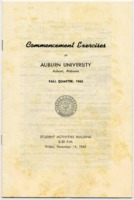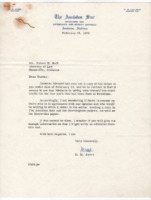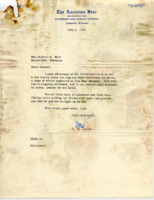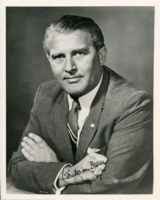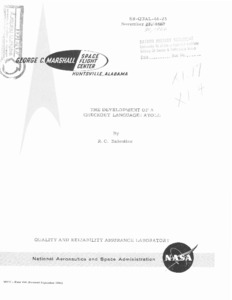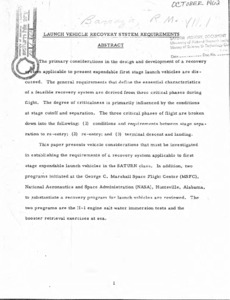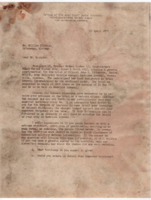
Browse Items (1976 total)
Sort by:
-
Commencement Exercises of Auburn University, fall quarter 1962.
The program includes the presentation of Doctor of Science, Honoris Causa, to William A. Mrazek. -
"Tiny Tots causing Traffic Jams..in your aisles? Eliminate them..."
The leaflet advertises Kiddie Rides to chain stores. These rides include the Tusko Elephant, Tusko Cow Pony, Tusko Kamel, Tusko Charger, and Tusko Geep. -
Correspondence between Robert K. Bell and Harry M. Ayers.
In response to Bell's February 13 letter from Edward Almond, Ayers informs Bell that he is attempting to find someone who would write a letter to newspaper publications in agreement with their opinion that Medaris is taking too much credit for his work. Bell responds that he is skeptical Ayers would find anyone as Medaris could make their life a "rather miserable existence". -
Letter to Robert K. Bell from Harry M. Ayers.
Ayers writes to Bell about an article written in The Anniston Star about him and the Nickerson trial and congratulates Bell for getting Nickerson "out as light as he did." -
Letter to Robert K. Bell from Harry M. Ayers.
Ayers writes regarding a wire from General Edward Almond to the National Department of the American Legion "calling on Eisenhower to exonerate our good friend Colonel John Nickerson." -
Oral History Interview With Michael Bacaro
Michael Bacato was born in Brooklyn, New York in 1927. When he started high school at the age of 14, Pearl Harbor was attacked by the Japanese. When he graduated high school, he enlisted in the Navy in 1945 so he wouldn't have to go into the Army. He stayed in the Navy for two years. In the Navy, Michael was on a crew of the Destroyer. When he got discharged from the Navy, he then started college in 1948. To help pay for college, he started working with the merch marines selling out oil tanks. He finished this in 1951. Michael started out in college at New York University, and soon after he almost had to go back to the Navy because North Korea invaded South Korea. To avoid going back, he joined the ROTC at NYU with the airforce. In 1952, he entered the extended active duty with the United States airforce as a second lieutenant. He went to Keesler Airforce Base for training, and he spent two years there. There, he became a Radar Officer. After his training, Michael then started to become interested with Von Braun, and the development of rockets in Huntsville, AL. He then finally made a decision to leave the airforce, and he moved to Huntsville to work. He went into the Mechanical Engineering Design group. One of the first projects he was assigned to was the life support system, working with two monkeys. He then was offered a job in the Bioengineering group, which he liked much better, so he decided to stay with this group. His last program he worked on was on the Hubble Telescope, where he had the opportunity to work with Buzz Aldron.Tags Oral History -
"The development of a checkout language : ATOLL."
ATOLL was developed to fulfill the requirements for a common computer language that could be used by the test engineers for launch and factory checkout. "ATOLL" is the abbreviated name for Acceptance, Test, Or Launch Language. -
"Launch Vehicle Recovery System Requirements."
The primary considerations in the design and development of a recovery system applicable to present expendable first stage launch vehicles are discussed. The general requirements that define the essential characteristics of a feasible recovery system are derived from three critical phases during flight. The degree of criticalness is primarily influenced by the conditions at stage cutoff and separation. The three critical phses of flight are broken down into the following: (1) conditions and requirements between stage separation to re-entry; (2) re-entry; and (3) terminal descent and landing. -
Letter to William Nichols from William G. Barry.
This letter requests William Nichols to be present at the trial as a defense witness and a written statement from Nichols to detail what his testimony would be. The letter includes questions for Nichols to answer in the written statement.
